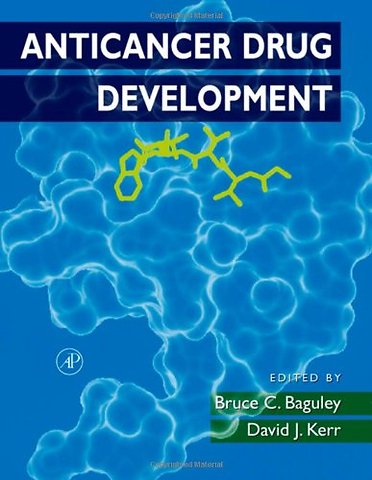<br>Contributors </br><br>Preface</br><br>Chapter 1 A Brief History of Cancer Chemotherapy</br><br> Summary </br><br> 1. Introduction </br><br> 2. Genotoxic (Cytotoxic) Therapy </br><br> 3. Growth Control Pathways </br><br> 4. Host–Tumor Interactions </br><br> 5. Conclusions </br><br> References </br><br>Chapter 2 Novel Targets in the Cell Cycle and Cell Cycle Checkpoints</br><br> Summary </br><br> 1. Introduction </br><br> 2. Molecular Regulation of Cell Cycle Progression </br><br> 3. Molecular Regulation of Cell Cycle Checkpoints </br><br> 4. Rationale for Targeting Cyclin-Dependent Kinases and Cell Cycle Checkpoint Pathways</br><br> 5. Agents and Strategies for Therapeutic Interference </br><br> 6. Conclusions </br><br> References </br><br>Chapter 3 Growth Factor and Signal Transduction Targets for Cancer Therapy</br><br> Summary </br><br> 1. Introduction </br><br> 2. The ErbB Family of Receptor Tyrosine Kinases (RTKs) </br><br> 3. The Ras-Raf-MEK-ERK Signaling Pathway </br><br> 4. c-Src Kinase, Signal Transduction, Transformation, and Cancer </br><br> 5. Akt </br><br> 6. Nuclear Hormone Receptors as Targets for Cancer Therapy </br><br> 7. Implications for Drug Discovery and Development </br><br> References </br><br>Chapter 4 Cell Death Pathways as Targets for Anticancer Drugs</br><br> Summary </br><br> 1. Introduction </br><br> 2. Two Main Pathways for Drug-Induced Apoptosis </br><br> 3. Modulation of Drug-Induced Cell Death by Bcl-2 and Related Proteins </br><br> 4. The Central Role of Caspases in Drug-Induced Apoptosis </br><br> 5. Synergy between Death Receptors and Cytotoxic Drugs </br><br> 6. The Rel/NF-kB/IkB Proteins </br><br> 7. Conclusion </br><br> References </br><br>Chapter 5 Drug Resistance Pathways as Targets</br><br> Summary </br><br> 1. Introduction </br><br> 2. Targeting Drug Transport </br><br> 3. Targeting Cellular Stress Responses </br><br> 4. Targeting DNA Repair Systems </br><br> 5. Conclusions </br><br> References </br><br>Chapter 6 Role of Matrix Metalloproteinases and Plasminogen Activators in Cancer Invasion and Metastasis: Therapeutic Strategies</br><br> Summary </br><br> 1. Introduction </br><br> 2. The Extracellular Matrix </br><br> 3. Cancer Invasion and Metastasis </br><br> 4. Cell Adhesion in Cancer </br><br> 5. Cancer Cell Motility </br><br> 6. Inflammatory Response to Cancer </br><br> 7. Proteolytic Enzymes Implicated in Cancer Invasion </br><br> 8. MMPIs as Novel Anticancer Agents </br><br> 9. Sheddases </br><br> 10. The uPA System: Proteolytic Control of MMP Activation </br><br> References </br><br>Chapter 7 Tumor Vasculature as a Target</br><br> Summary </br><br> 1. Introduction </br><br> 2. How to Inhibit Tumor Angiogenesis </br><br> 3. Concluding Remarks </br><br> References </br><br>Chapter 8 Gene-Directed Enzyme Prodrug Therapy</br><br> Summary </br><br> 1. Introduction </br><br> 2. Background </br><br> 3. Enzyme-Prodrug Systems </br><br> 4. Tailored Prodrugs for GDEPT </br><br> 5. The Activation Process </br><br> 6. Augmenting the Effect </br><br> 7. Exploiting the Bystander Effect and Acquired Immunity </br><br> 8. Conclusions </br><br> References </br><br>Chapter 9 Tumor Antigens as Targets for Anticancer Drug Development</br><br> Summary </br><br> 1. Introduction </br><br> 2. Antigen Targets for Cancer Vaccines </br><br> 3. Tumor Antigens as Targets for Antibody-Based Therapeutics </br><br> References </br><br>Chapter 10 Structure-Based Drug Design and its Contributions to Cancer Chemotherapy</br><br> Summary </br><br> 1. Introduction</br><br> 2. Antimetabolites </br><br> 3. Protease Inhibitors </br><br> 4. Protein Kinase Inhibitors </br><br> 5. Other Targets</br><br> 6. Novel Methods in Structure-Based Drug Design </br><br> 7. Conclusions and Current Questions </br><br> References </br><br>Chapter 11 The Contribution of Synthetic Organic Chemistry to Anticancer Drug Development</br><br> Summary </br><br> 1. Introduction </br><br> 2. Early Rationality </br><br> 3. The Random Screening Era: Directly from Screen to Clinic </br><br> 4. Organic Synthesis Catches Up: Development of National Product Leads </br><br> 5. Development of Synthetic Compounds: Structure–Activity Relationships </br><br> 6. Immunotoxins: Synthetic Organic Chemistry Applied to Large Molecules </br><br> 7. Organic Synthesis in Rational Design: Tumor-Activated Prodrugs of Cytokines </br><br> 8. Early Genomics: Inhibitors of Transmembrane Tyrosine Kinases </br><br> 9. The Genomics/Proteomics Era: Combinatorial Chemistry </br><br> 10. Conclusion </br><br> References </br><br>Chapter 12 Biosynthetic Products for Anticancer Drug Design and Treatment: The Bryostatins</br><br> Summary </br><br> 1. Introduction </br><br> 2. Background to the Bryostatins </br><br> 3. Comprehensive Review of Bryostatin Scientific and Medical Reports </br><br> References </br><br>Chapter 13 DNA-Encoded Peptide Libraries and Drug Discovery</br><br> Summary </br><br> 1. Introduction </br><br> 2. Methods for DNA-Encoded Peptide Display </br><br> 3. Applications for DNA-Encoded Peptide Libraries </br><br> 4. Conclusions </br><br> References </br><br>Chapter Mechanism-Based Highthroughput Screening for Novel Anticancer Drug Discovery</br><br> Summary </br><br> 1. Importance of Mechanism-Based Targets in Postgenomic Drug Discovery </br><br> 2. High-Throughput Screening </br><br> 3. Assay Technologies </br><br> 4. Assay Performance and Downstream Evaluation of Bits </br><br> 5. Compounds for HTS </br><br> 6. Examples of Compounds Identified Through Screening Approaches </br><br> 7. Future HTS Developments </br><br> 8. Concluding Remarks </br><br> References </br><br>Chapter 15 Tumor Cell Cultures in Drug Development</br><br> Summary </br><br> 1. Introduction </br><br> 2. Growth Inhibition Assays </br><br> 3. Clonogenic Assays </br><br> 4. Three-Dimensional Cell Cultures: Modeling Extravascular Drug Transport </br><br> 5. Modeling of in Vivo Activity by in Vitro Assays </br><br> 6. Perspective </br><br> References </br><br>Chapter 16 Screening Using Animal Systems</br><br> Summary </br><br> 1. Introduction </br><br> 2. Choice of in Vivo Systems for Large-Scale Drug Development </br><br> 3. Combined in Vitro/in Vivo Testing Procedure Using Human Tumor Xenografts—The Freiburg Experience </br><br> 4. Use of Transgenic Animals in the Search for New Drugs </br><br> 5. Screening for Angiogenesis Inhibitors </br><br> References </br><br>Chapter 17 Relevance of Preclinical Pharmacology and Toxicology to Phase I Trial Extrapolation Techniques: Elevance of Animal Toxicology</br><br> Summary </br><br> 1. Introduction </br><br> 2. Historical Perspective </br><br> 3. Special Toxicity Evaluations </br><br> 4. Recent Examples of Drug Development at NCI </br><br> 5. Predictability of Nonclinical Animal Data </br><br> 6. Conclusions </br><br> References </br><br>Chapter 18 Clinical Trial Design: Incorporation of Pharmacokinetic, Pharmacodynamic, and Pharmacogenetic Principles</br><br> Summary </br><br> 1. Introduction </br><br> 2. Rationale for Chemotherapy Optimization</br><br> 3. Pharmacokinetic–Pharmacodynamic Relationships </br><br> 4. Pharmacogenetics </br><br> 5. Strategies to Improve Therapeutic Index </br><br> 6. Conclusion and Perspectives </br><br> References </br><br>Chapter 19 Tumor Imaging Applications in the Testing of New Drugs</br><br> Summary </br><br> 1. Introduction </br><br> 2. Positron Emission Tomography </br><br> 3. PET in New Drug Evaluation </br><br> 4. Conclusions </br><br> References </br><br>Chapter 20 Mechanistic Approaches to Phase I Clinical Trials</br><br> Summary </br><br> 1. Introduction </br><br> 2. Mechanism-Based Studies of Established Anticancer Agents to Assess Target Inhibition </br><br> 3. Mechanistic Trial Perspectives on Anticancer Agents with Novel Mechanisms </br><br> 4. Potential of PET Scanning in the Assessment of Pharmacodynamic End Points </br><br> 5. Conclusion </br><br> References </br><br>Index </br>
